11 Interesting Facts About Abigail Adams You Never Knew
You might be surprised to learn that Abigail Adams' birth date was misreported due to a calendar shift, and she struggled with spelling despite her literary prowess. During the Revolutionary War, she melted pewter spoons to make musket balls for troops. Abigail exchanged over 1,100 letters with her husband John, providing invaluable insights into early American history. Her famous "remember the ladies" letter pioneered women's rights advocacy. As the first resident of the White House, she faced numerous challenges, including unfinished construction and lack of amenities. These lesser-known facts offer a glimpse into the multifaceted life of this influential First Lady. Exploring further reveals even more intriguing aspects of her remarkable legacy.
This post may contain affiliate links. If you make a purchase through these links, I may earn a commission at no additional cost to you. Additionally, portions of this post may be generated using artificial intelligence (AI) technology. While we strive for accuracy, please be aware that AI-generated content may not always be perfect and should be fact-checked when necessary.
The Spatula Scoops
- Abigail Adams made musket balls for Revolutionary troops by melting pewter spoons during wartime scarcity.
- She exchanged over 1,100 letters with John Adams, providing unique insights into America's formative years.
- Abigail faced significant challenges in the unfinished White House, including lack of heating and proper furnishings.
- Her famous "Remember the Ladies" letter became a catalyst for early discussions on women's rights in America.
- Despite being self-educated, Abigail developed into an avid reader and writer, demonstrating significant literary skill.
Birth Date Confusion
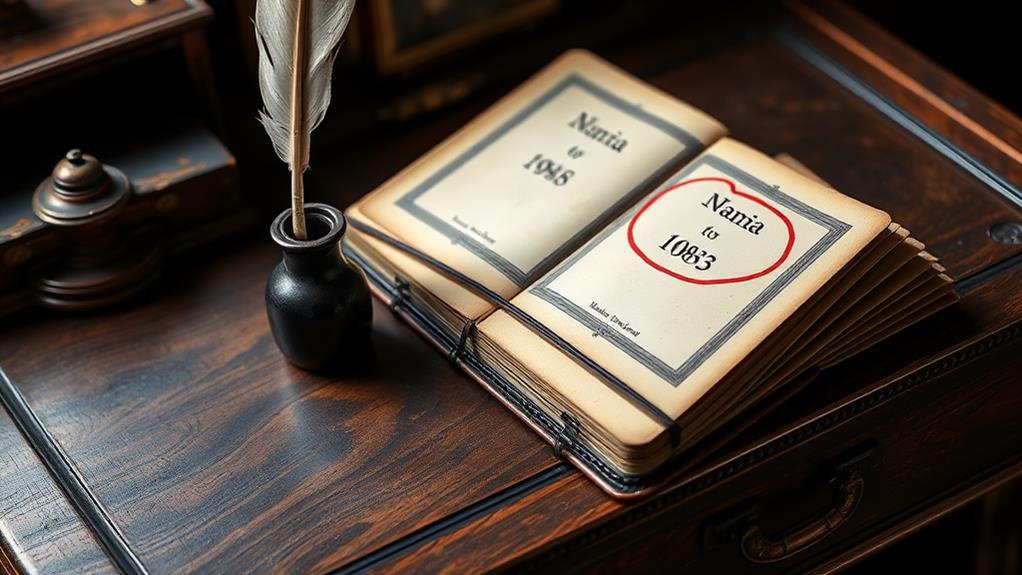
For over two centuries, confusion has surrounded Abigail Adams's birth date. You might be surprised to learn that many historical accounts have incorrectly listed November 11, 1744, as the day Abigail Smith was born. In reality, she entered the world on November 22, 1744, in Weymouth, Massachusetts. This discrepancy stems from a significant calendar shift that occurred during her lifetime.
When Abigail was born, American subjects used the Julian calendar. However, in 1752, Britain adopted the Gregorian calendar, causing a ten-day shift. This change led to the persistent misreporting of her birth date in various historical records. It's a prime example of the challenges historians face when documenting women's lives from that era.
Abigail's upbringing was unique for her time. As the daughter of Reverend William Smith and Elizabeth Quincy Smith, she was raised in an intellectually stimulating environment. Unlike many girls of her era, who received little formal education, Abigail was taught at home, laying the foundation for her future role as a prominent historical figure. This birth date confusion serves as a reminder of the complexities in accurately recording history, especially concerning women's lives.
Spelling Struggles and Literary Prowess

Despite her occasional spelling missteps, Abigail Adams's literary prowess shone through in her extensive correspondence. You might be surprised to learn that Abigail struggled with common typos like "perticular" and "benifit," but her self-consciousness about spelling didn't hinder her intellectual growth. She educated herself using her father's library and household materials, becoming an avid reader and accomplished writer.
Abigail's letters, especially those exchanged with John Adams, offer critical insights into early American society and politics. Her writing showcases:
- A keen understanding of complex political issues
- Eloquent articulation of personal experiences
- Strong advocacy for women's education
You'll find that Abigail's correspondence isn't just historically significant; it's a reflection of her literary skills. She believed that literacy and civic duty were intertwined, emphasizing that educated women could contribute to better governance. Despite her spelling challenges, Abigail's ability to express her thoughts on governance, social issues, and personal experiences makes her letters valuable literary assets. Her works demonstrate that imperfect spelling doesn't diminish one's capacity for powerful, influential writing.
Revolutionary Bullet Maker
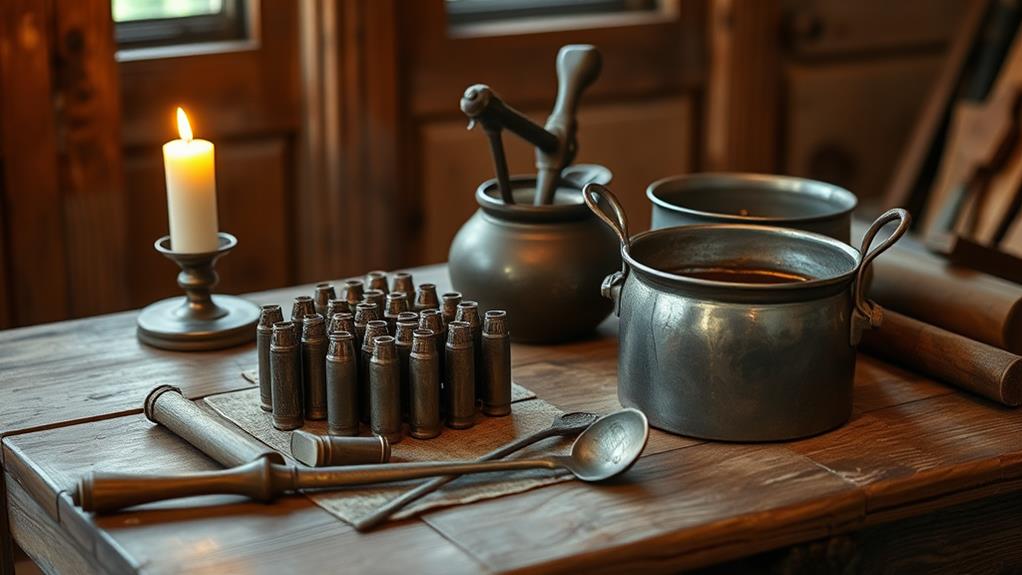
You might not expect a Founding Father's wife to be involved in making bullets, but Abigail Adams played an essential role in the American Revolution. As a resourceful "bullet maker," she melted down pewter spoons to create musket balls for the troops. This act demonstrated her unwavering commitment to the war effort and showcased the active role women played in supporting the revolutionary cause.
While her husband, John Adams, was away, Abigail managed supplies and resources for her family during wartime scarcity. Her practical skills and resourcefulness were important in maneuvering the challenges of the Revolutionary War. Abigail's contributions weren't just limited to bullet-making; they were part of a broader movement where women participated in various capacities to support independence.
In her letters, Abigail expressed the personal sacrifices she made, capturing the emotional toll of wartime life. She balanced domestic responsibilities with Revolutionary duties, exemplifying the dedication of women during this tumultuous period. Abigail Adams's actions as a bullet maker symbolize the often-overlooked but significant involvement of women in securing America's independence.
Prolific Correspondence With John
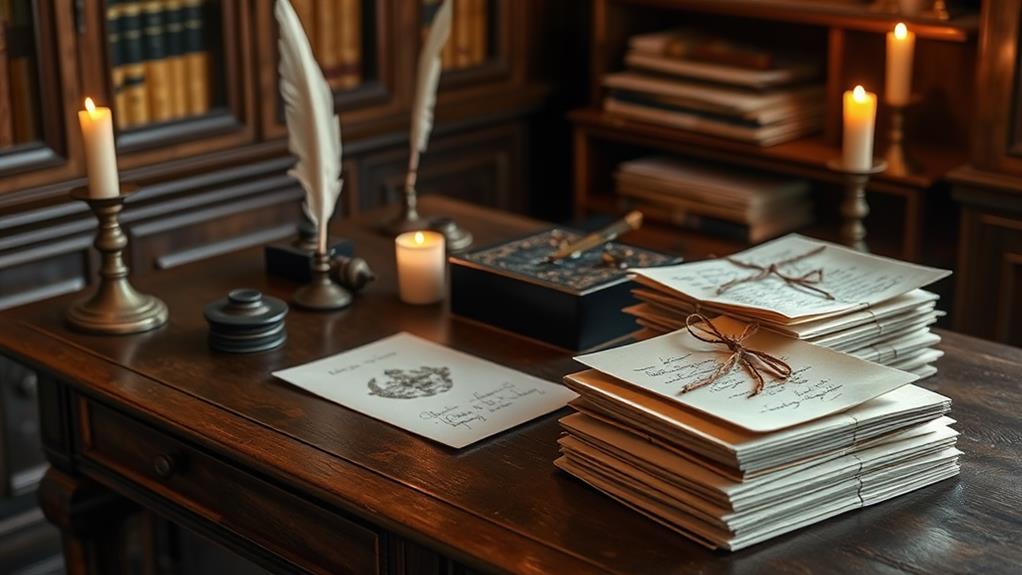
Beyond her wartime contributions, Abigail Adams's most enduring legacy lies in her prolific correspondence with her husband, John Adams. You might be surprised to learn that they exchanged over 1,100 letters throughout their marriage, spanning more than five decades. This extensive collection provides a unique window into their thoughts on love, politics, and family during America's formative years.
Abigail's letters weren't just expressions of affection; they were filled with political insights that often influenced John's decisions as Vice President and President. Her most famous letter, written on March 31, 1776, urged John to "remember the ladies" when framing new laws, marking an early push for women's rights in America.
Here are three key aspects of their correspondence:
- It began before their marriage in 1764 and continued for over 50 years
- The letters document their experiences during significant historical events
- Their writings reflect a deep emotional bond and intellectual partnership
Through these letters, you can witness the shared commitment of Abigail and John Adams to their country and family, offering a fascinating glimpse into the personal lives of two key figures in American history.
Women's Rights Pioneer
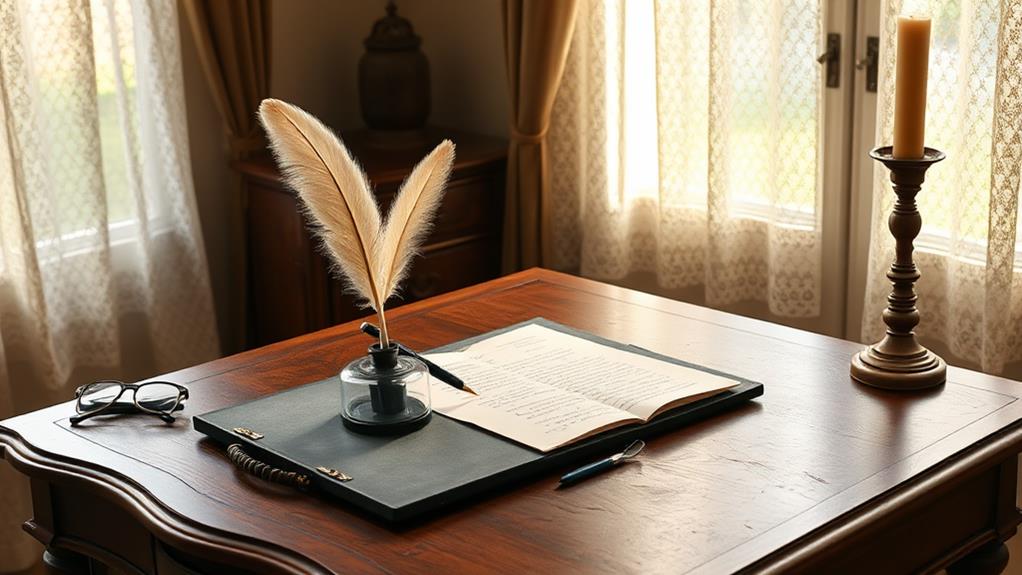
Abigail Adams's famous "Remember the Ladies" letter to her husband John Adams in 1776 marked her as an early champion of women's rights. You'll find that she urged him to take into account women's interests when drafting new laws, pushing for greater representation and property rights. Her advocacy extended to women's education, as she believed that educated women would play a vital role in shaping society and governance.
"Remember the Ladies" Letter
On March 31, 1776, in the midst of the American Revolution, a letter was penned that would echo through generations. Abigail Adams wrote to her husband, John Adams, urging him to "remember the ladies" as he helped shape the new nation's laws. This revolutionary message challenged the societal norms of the time, advocating for women's rights and representation in government.
In her letter, Abigail highlighted three key points:
- Women's legal rights should be protected
- Men might become tyrants if given unchecked power
- The concept of coverture should be abolished
You might not know that Abigail specifically addressed the issue of property rights for married women. She argued against coverture, a legal doctrine that stripped wives of their legal identities and property rights. By doing so, she laid the groundwork for future discussions on gender inequality and women's rights in America.
Although Abigail didn't support women's suffrage later in life, her early advocacy was groundbreaking. Her letter served as a catalyst for change, inspiring future generations to continue the fight for women's rights and representation in American society.
Education Advocacy Efforts
Throughout her life, Abigail Adams championed women's education as a cornerstone of societal progress. You'll find that her advocacy efforts were groundbreaking for her time. She firmly believed that educated women could contribute markedly to better governance and societal norms.
Abigail collaborated with contemporary thinkers like Judith Sargent Murray to promote educational opportunities for women. They argued that mothers played a vital role in nurturing virtuous citizens, emphasizing the importance of education in this process. Abigail's vision for women's rights extended beyond education, encompassing legal recognition and property rights.
Here's a summary of Abigail Adams' key advocacy efforts:
| Area of Advocacy | Specific Focus |
|---|---|
| Education | Women's access |
| Legal Rights | Property ownership |
| Citizenship | Nurturing virtuous citizens |
| Equality | Opposition to slavery |
| Governance | Women's participation |
Abigail's commitment to human dignity and rights for all individuals is evident in her opposition to slavery. This stance further expanded her views on equality, demonstrating a holistic approach to social progress. Her efforts laid the groundwork for future generations of women's rights advocates, making her a true pioneer in the fight for equality.
What Can We Learn About Abigail Adams by Comparing Her Life to Langston Hughes’?
Abigail Adams and Langston Hughes, though from different eras, both championed change and justice. By comparing their lives, we see shared courage in defying norms for progress. Alongside interesting facts about langston hughes revealed, exploring Abigail’s letters shows her advocacy mirrored in Hughes’ poetry, both inspiring action through words and resilience.
White House's First Resident
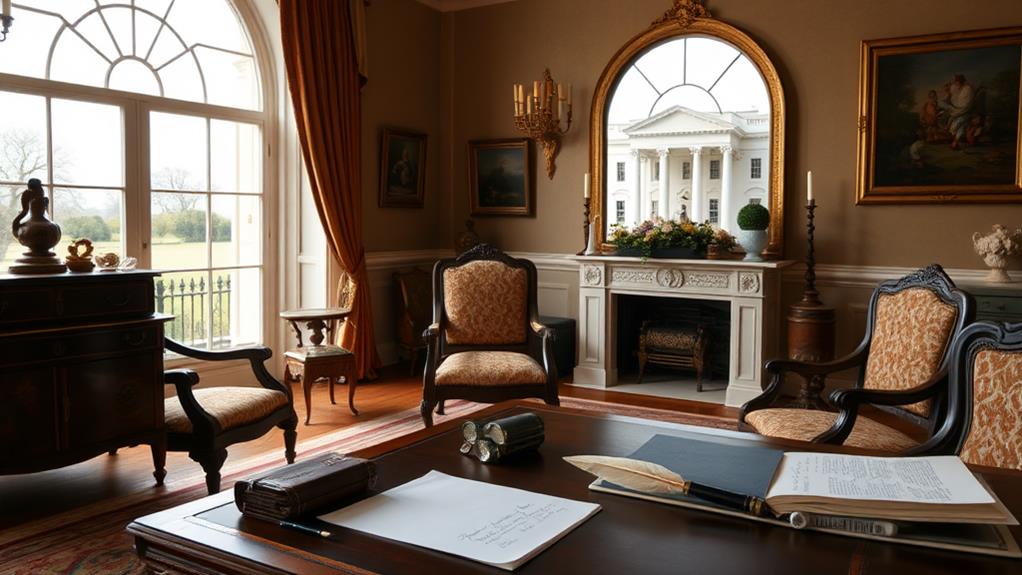
Abigail Adams faced significant challenges as the first resident of the White House, which was still under construction when she moved in on November 1, 1800. You might imagine the difficulties of hosting social events and public receptions amidst the chaos of an unfinished building, with limited furnishings and inadequate facilities. Despite these obstacles, Abigail pioneered the role of first lady, managing the household and social functions while also providing political insight to her husband, President John Adams, setting important precedents for future first ladies in American history.
Unfinished Presidential Mansion Challenges
Despite the prestige of being the first residents of the White House, Abigail Adams and her husband faced significant challenges upon their arrival on November 1, 1800. The presidential mansion was far from complete, leaving the Adams family to contend with:
- Lack of proper heating
- Insufficient furnishings
- Ongoing construction work
You might wonder how they managed in such conditions. As the first lady, Abigail took charge of the situation, showcasing her leadership skills in the face of adversity. She organized social events and receptions, setting a precedent for future first ladies, all while maneuvering the hurdles of an unfinished White House.
The Adams family's commitment to establishing Washington, D.C. as the new political center was evident in their willingness to endure these hardships. Abigail's adaptability shone through as she managed logistics and social engagements with limited resources. Her efforts in those early days of the presidency demonstrate the vital role played by first ladies in shaping the White House's social and political functions.
You can appreciate the determination and resourcefulness required to turn an incomplete construction site into a functioning presidential mansion, a reflection of Abigail Adams' resilience and ingenuity.
Hosting Amid Construction Chaos
Amid the dust and disorder of the unfinished White House, Abigail Adams didn't let construction chaos dampen her spirit or hinder her duties. As the first lady and first resident of the presidential mansion, she faced unique challenges in hosting events and fostering community engagement.
You might wonder how she managed to entertain guests in such an environment. Here's a glimpse into her adaptability:
| Challenge | Abigail's Solution |
|---|---|
| Unfinished rooms | Strategically arranged furniture |
| Ongoing construction | Scheduled events around work hours |
| Limited amenities | Improvised with available resources |
| Dust and debris | Frequent cleaning and creative decor |
| Lack of staff | Enlisted family members to help |
Despite these obstacles, Abigail's commitment to social engagement shone through. She hosted a memorable Christmas party in 1800, turning the unfinished White House into a hub of political discourse and community connection. Her ability to navigate these challenges set a precedent for future first ladies, demonstrating the importance of adaptability in the role.
Abigail's management skills were vital in establishing the White House as a center for social and political activities, even as construction continued around her. Her efforts laid the groundwork for the presidential mansion's future as a symbol of American democracy.
Pioneering First Lady Duties
Stepping into uncharted territory, the role of First Lady took on new meaning when Abigail Adams became the White House's first resident. As she moved into the unfinished building on November 1, 1800, Abigail faced unique challenges that would shape the expectations for future First Ladies.
Despite the ongoing construction, Abigail wasted no time in establishing her duties:
- She hosted public receptions, including her first on January 1, 1801
- She managed social events in the incomplete capital city
- She opened the White House to visitors, setting a precedent for future First Ladies
You might be surprised to learn that Abigail's role extended beyond that of hostess. She actively engaged in political discussions, serving as a trusted advisor to her husband, John, during his administration. This dual role of hostess and political confidante set a new standard for First Ladies to come.
Abigail's management skills and ability to balance personal responsibilities with public duties laid the foundation for the expectations of future First Ladies. Her pioneering efforts in the White House helped define the role as we understand it today, blending social grace with political acumen.
Frequently Asked Questions
What Are Some Cool Facts About Abigail Adams?
Knowledge is power, and you'll be empowered by these cool facts about Abigail Adams. You might not know that she was the first First Lady to live in the White House, moving in while it was still unfinished. She exchanged over 1,100 letters with her husband John, providing invaluable insights into early American life. Abigail advocated for women's rights, urging John to "remember the ladies" in new laws. She loved dogs, particularly her pet Juno, showcasing her softer side amidst political life.
What Was Abigail Adams' Nickname?
You might be surprised to learn that Abigail Adams had several nicknames. Her husband, John Adams, affectionately called her "Dearest Friend" in their letters. Others referred to her as "Mrs. President" due to her influence on her husband's political career. During her time as First Lady, she was known as "the First Lady of the Republic." She was also called "the Lady of the House" for her domestic management skills. Formally, she was often addressed as "Mrs. Adams" in correspondence and public life.
How Many Kids Did Abigail Adams Have?
You might be surprised to learn that Abigail Adams had five children with her husband, John Adams. Their family consisted of three daughters and two sons: Abigail (nicknamed "Nabby"), John Quincy, Susanna, Charles, and Thomas. John Quincy Adams later became the sixth President of the United States. Abigail's role as a mother was central to her life, and she often wrote about her children's education and future in her letters. Despite frequent separations due to John's political duties, she managed their upbringing actively.
How Old Was Abigail Adams When She Died?
You might be surprised to learn that Abigail Adams lived to a respectable age for her time. She died at 73 years old, passing away on October 28, 1818. She'd seen remarkable changes in her lifetime, from the American Revolution to the early years of the United States. Despite facing health challenges in her later years, Abigail's influence on politics and women's rights endured. She outlived her husband, John Adams, by nearly seven years, leaving behind a lasting legacy.





